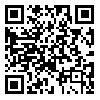BibTeX | RIS | EndNote | Medlars | ProCite | Reference Manager | RefWorks
Send citation to:
URL: http://payavard.tums.ac.ir/article-1-5799-en.html
2- Master of Science in Public Health in Nutrition, Nutrition Unit, Ali-ebne-Abitaleb Hospital, Rafsanjan University of Medical Sciences, Rafsanjan, Iran
3- Associate Professor, Clinical Nutrition Department, School of Nutritional Sciences and Dietetics, Tehran University of Medical Sciences, Tehran, Iran ,
Background and Aim: Considering the potential damages caused by inaccurate, inadequate and incomplete information published in web pages, the aim of this study was to evaluate Persian-language web pages containing nutritional information, using Silberg criteria.
Materials and Methods: Internet pages related to nutrition were found in “peyvandha.ir” and by searching 20 nutrition-related keywords in five search engines. The first fifty results of every keyword in every search engine were evaluated according to the inclusion criteria. From every website/weblog, three issues were randomly chosen. The Silberg checklist and the qualitative questionnaire were completed and the data were analyzed using SPSS software.
Results: In total, 56 websites /weblogs (47 websites and 9 weblogs) were found to have nutrition-related information. Among these websites/weblogs, 40 were active in the field of nutrition, 14 in health-related fields, and the rest in news, general information and cooking. Mean Silberg score (out of 9) was 2.3±1.9 for websites and 1.75±1.3 for weblogs. The highest score in this study was 8 (one website) and the lowest score was zero (13 websites/weblogs). In 82.5% of websites/weblogs, the sources used in compiling the articles were not mentioned and 64.9% of them lacked their authors’ names. Of all websites/weblogs, 94% didn’t have any disclaimer rejecting the responsibility for accuracy of the information.
Conclusion: Due to the poor quality of internet pages on the one hand and the importance of nutritional knowledge on the other, the development of reliable Persian-language web pages to improve public awareness of nutritional issues is necessary.
| Rights and permissions | |
 |
This work is licensed under a Creative Commons Attribution-NonCommercial 4.0 International License. |





